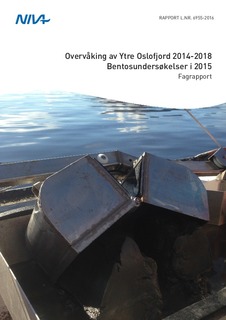Overvåking av Ytre Oslofjord 2014-2018. Bentosundersøkelser i 2015. Fagrapport
Research report
Published version
Permanent lenke
http://hdl.handle.net/11250/2478418Utgivelsesdato
2016Metadata
Vis full innførselSamlinger
- NIVA-rapporter [6995]
- Publikasjoner fra Cristin - NIVA [2149]
Sammendrag
Overvåkningsprogrammet for bunnområdene i Ytre Oslofjord skal fremskaffe informasjon om miljøtilstanden hos bunndyrsamfunn med fokus på eutrofiering. I 2015 ble det foretatt undersøkelser av fauna på bløtbunn ved grabbing på 10 stasjoner. Alle stasjonene i Hvaler-området og Ytre Oslofjord blei henhold til vannforskriften klassifisert til å ha «god tilstand» for bløtbunnsfauna, med unntak av en stasjon ved Kjøkøy (D-2) som ble klassifisert til å ha «moderat tilstand». Iddefjorden var tydelig organisk belastet, med høyt innhold av TOC og lukt av H2S i sedimentet og 2 stasjoner (ID-1 og ID-43, begge ca. 2 km fra Halden) ble klassifisert til å ha «dårlig tilstand» for bløtbunnsfauna, mens en stasjon (R-5,) litt lenger ut i Ringdalsfjorden ble klassifisert til å ha «god tilstand». Benthic investigations in Outer Oslo fjord included in 2015 surveys of soft bottom fauna at 10 stations by
grabbing, with three replicate samples at each station. Most of the stations in the Hvaler estuary and open
part of the Outer Oslo fjord could be classified to be in “good condition” (condition class 2). The
exception was one station (D-2) near the island Kjøkøy in the Hvaler estuary which could be classified to
be in "moderate condition”. The Iddefjord was clearly organic polluted and the sediments showed
relatively high concentrations of total organic carbon (TOC) and odor of H2S. Based on the makrofauna
date two stations in the Iddefjord/Ringdalsfjord (ID-1 and ID-43) could be classified to be in "poor
condition, while station R-5 a bit further out could be classified to be in "good condition."

